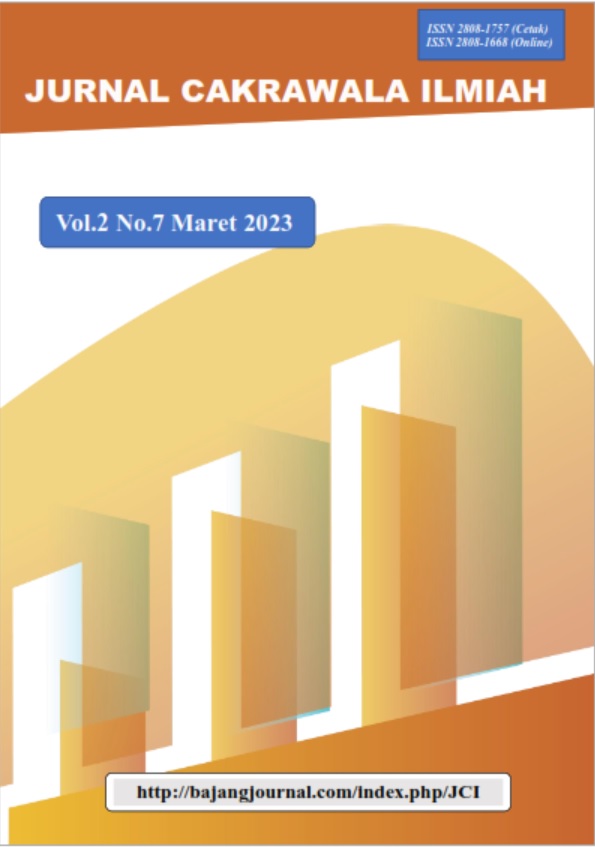DETERMINATION OF OPTIMUM DOSE OF MIXING WASTEWATER WWTP (WAST WATER TREATMENT PLANT) WITH HOT WATER PRODUCTION LEMATANG RIVER AS OF PARAMETERS PH, CONDUCTIVITY, TURBIDITY, AND SILICA USE COAGULANT PAC IN PT.X
DOI:
https://doi.org/10.53625/jcijurnalcakrawalailmiah.v2i7.5383Keywords:
Mixture of river water and waste water,, power plant, koaglanAbstract
Water rivers Lematang commonly used by the community to meet the needs of households and industry around the region . The industry that uses Lematang river water is PLTU as its raw material for production . Apart from that, PLTU also produces liquid waste. The liquid waste comes from ( wast water treatment plant ) which can still be utilized because it has a turbidity value that is still below the max 5 NTU and the pH is still between 6 to 9 . Regarding this,power plant power plant Banjarsari apply the principles of waste control carefully and integrated namely Systems Wastewater Treatment ( Waste Water Treatment Plant ) . In the processing process, it acts as a purifier for a mixture of Lemaang river water and wastewater. Menggunakan coagulant (Poly Aluminum cloride) so it can be reused as water the additional production. The results showed that the mixture of lematang river water with waste water (wast water treatment plant) was 60% : 40% , this indicates the use of the optimum dose as production water. waste water can be used as additional water to be used as production water because the pH value is 7.65; conductivity 187.6; turbidity 4.45; and silica 1.92 . Based on the results of research by utilizing river water and waste water the most effective is the dose ratio of 60%: 40% .
References
Amri, Khairul; 2018, Pengaruh Penambahan PAC (Poly Aluminium Choride) dan Soda Ash Terhadap pH, Turbiditas dan TDS (Total Dissolved Solids) Pada Air Baku PDAM Tirtanadi Martubung Medan, Fakultas Matimatika dan Ilmu Pengetahuan Alam, Universitas Sumatera Utara, Medan.
Benefield, L.D., Judkins, J.F., & Weand, B.L. (1982). Process Chemistry For Water and Waste Water Treatment. Prentice Hall Inc
Budiman, Anton, Candra Wahyudi, Wenny Irawati, Herman Hindarso, 2008; Kinerja Koagulan Poly Aluminium Chloride (PAC) Dalam Penjernihan Air Sungai Kalimas Surabaya Menjadi Air Bersih, Widya Teknik Vol. 7, No. 1, 2008 (25-34)
Emmer, Frank N;1988. The Nalco Water Handbooks. Second Edition, Mc Graw-Hill
Kristijarti, A. Prima; Ign Suharto, Marieanna, 2013; Penentuan Jenis Koagulan dan Dosis Optimum untuk Meningkatkan Efisiensi Sedimentasi dalam Instalasi Pengolahan Air Limbah Pabrik Jamu X, Universitas Katolik Parahyangan, Bandung.
Siahaan, Sherly. 2017. Perhitungan Jumlah Bahan Kimia Pada Eksternal Water Treatment. Bekasi: Politeknik kelapa Sawit Citra Widya Edukasi
Siregar, Ahdiat Leksi. 2013. Modul Water Treatment Plant. Bekasi: Politeknik Kelapa Sawit Citra Widya Edukasi.(buku diktat)
Sutrisno, 2004. Ciri-Ciri Kualitas Air Yang Baik Secara Fisik. (online), (http://www.artikellingkunganhidup.com/ciri-ciri-kualitas-air-yang-baik-secara fisiknya.html)
Suyanta. 2002. Analisis Kualitas Air Sumur di Daerah Aliran Sungai Code. Yogyakarta. Jurnal Kimia Lingkungan. 4 (1) : 55-5
Ningtyas, R. (2015). Pengolahan Air Limbah dengan Proses Lumpur Aktif. Academia 2015, 1–11.
Ningrum, S. O. (2018). Analisis Kualitas Badan Air Dan Kualitas Air Sumur Di Sekitar Pabrik Gula Rejo Agung Baru Kota Madun. Jurnal Kesehatan Lingkungan, 10(1), 1– 12.
Nursanti, I. (2013). Karakteristik Limbah Cair Pabrik Kelapa Sawit Pada Proses Pengolahan Anaerob dan Aerob. Jurnal Ilmiah Universitas Batanghari Jambi, 13(4), 67–73.
Marsandi, (2018). Operation Water Treatment Plant PT.PLN Handbooks. PT.X
Downloads
Published
How to Cite
Issue
Section
License
Copyright (c) 2023 Jurnal Cakrawala Ilmiah

This work is licensed under a Creative Commons Attribution-NonCommercial 4.0 International License.
















